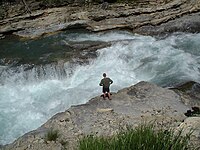
Photo from wikipedia
Velocity dispersion is a common phenomenon for fluid-charged porous rocks and carries important information on the pore structure and fluid in reservoir rocks. Previous ultrasonic experiments had measured more significant… Click to show full abstract
Velocity dispersion is a common phenomenon for fluid-charged porous rocks and carries important information on the pore structure and fluid in reservoir rocks. Previous ultrasonic experiments had measured more significant non-Biot velocity dispersion on saturated reservoir sandstones with increasing pore-fluid viscosity. Although wave-induced local squirt-flow effect could in theory cause most of the non-Biot velocity dispersion, its quantitative prediction remains a challenge. Several popular models were tested to predict the measured velocities under undrained conditions, but they either underestimated the squirt-flow effect or failed to simultaneously satisfy P- and S-wave velocity dispersions (especially for higher viscosity fluids). Based on the classic double-porosity theory that pore space is comprised of mainly stiff/Biot’s porosity and minor compliant porosity, an effective “wet frame” was hypothesized to account for the squirt-flow effect, whose compliant pores are filled with a hypothesized fluid with dynamic modulus. A new dynamic elastic model was then introduced by extending Biot theory to include the squirt-flow effect, after replacing the dry-frame bulk/shear moduli with their wet-frame counterparts. In addition to yielding better velocity predictions for P- and S-wave measurements of different fluid viscosities, the new model is also more applicable because its two key tuning parameters (i.e., the effective aspect ratio and porosity of compliant pores) at in situ reservoir pressure could be constrained with laboratory velocity measurements associated with pore-fluid viscosities.
Journal Title: Geophysics
Year Published: 2020
Link to full text (if available)
Share on Social Media: Sign Up to like & get
recommendations!